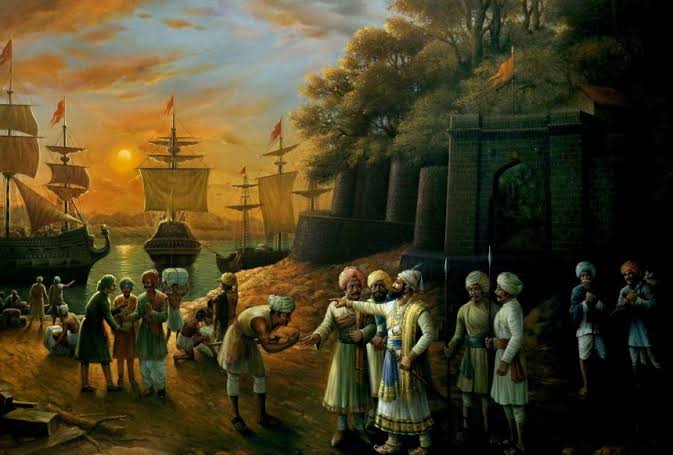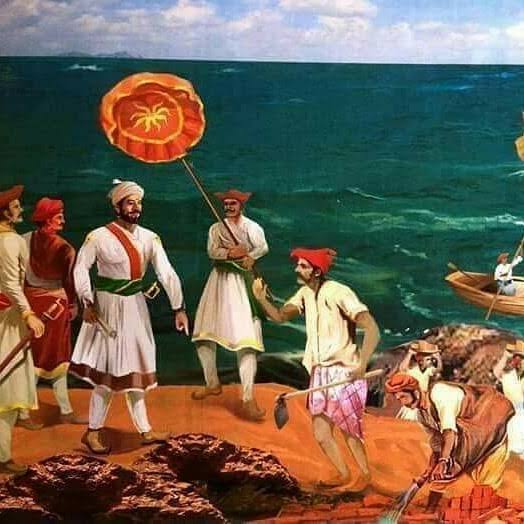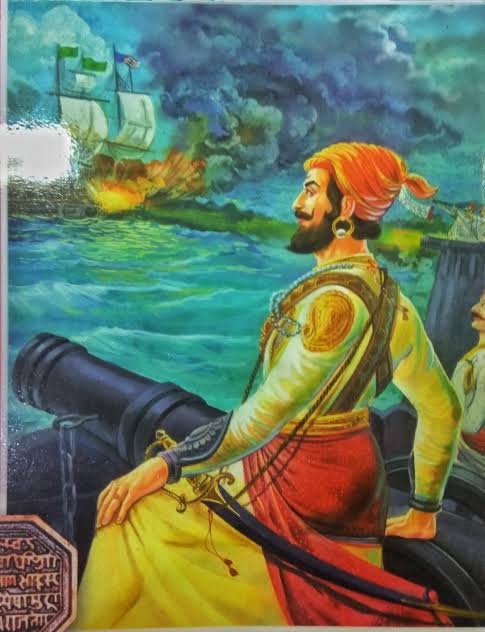In the early hours of February 13, 1665, the clueless Portuguese soldiers woke up to the roar of ‘Har Har Mahadev’ and ‘Jai Maa Bhavani’ from the Maratha Navy. In the battle which ensued Maratha Navy decisively and routed the Portuguese, Swaraj’s Saffron flag was unfurled in Basruru.
Ramachandra Pant Amatya, a close associate of the founder of Hindavi Swarajya, Yugapravartak Shree Shivaji Chhatrapati Maharaj, has written the famous code of civil and military administration called ‘Aajnapatra’. He writes about the administrative system and composition of Maratha navy as – “Shivaji Maharaj’s Navy is an autonomous branch of the state. Shivaji Maharaj has been described as the king who has a strong cavalry force, and the whole of the earth is his subject. In those days it was said that the kingdom that has a strong Navy rules over the sea.” By applying the same formula and the intention to secure the Swaraj coast, Shivaji Maharaj formed the navy as soon as he won the Kalyan-Bhiwandi territory on October 24 1657. Since navy was very new to Marathas, he gave the shipbuilding contract to a Portuguese engineer Rui Lentav Viegas and his son Fernav Viegas. But then smartly had the local Maratha community shadow them and their crews to gain expertise in shipbuilding. Initially, when British saw a fleet of 18-20 ships that sailed from the dock of Kalyan to the bay of Vasai, the British also doubted its power but what seemed small, blossomed into a full-fledged Navy by 1664. In those times, India’s coast was dominated by the colonial forces who considered themselves as rightful rulers of the sea and did not seem to be afraid of this emerging Maratha Navy. They considered below par to even making a passing reference to the Maratha navy.

The self-sufficient Marathi Navy that was entirely indigenous in its composition then decided to teach these colonial forces a lesson and end their hegemony over the sea. Around the same time, Bednur (Keladi kingdom) ruler in Karnataka, Shri Somashekhar Nayak, sent his counsel to Shivaji Maharaj with a request to liberate the ports and prosperous trading centres of Basruru and Gangoli from the clutches of Portuguese. Shivaji Maharaj had already decided to flex the muscle of Maratha Navy but now had a reason to do so in the form of the invitation from Bednur. Without any further delay, Shivaji Maharaj convened a meeting of his Naval officers and formulated a plan.
The pretext was the celebrate Mahashivaratri at Gokarna Mahabaleshwar and to hoodwink the colonial naval forces.
On the third day of Hindu month of Phalgun, Shukla paksha, i.e. February 8, 1665, a fleet of 85 small warships and three large ships bedecked with saffron flags assembled at the Gulf of Malavan at the sea fort of Sindhudurg. Shivaji Maharaj leads this first naval expedition of Maratha Navy. This then was also the only Naval Expedition of Shivaji Maharaj in his lifetime. He was accompanied by expert naval officers Daryasarang Mayank Bhandari, Ventatji Sarangi and Daulat Khan. The Maratha Navy successfully circumvented the Dutch trade headquarters at Vengurla, Portuguese naval headquarters at Panaji & Vasco-Goa and the British trade centre at Karwar. Only after Maratha navy went to Ankola, Gokarna, Mirjan, Honnavar, Bhatkal, Gangoli, Basruru and returned to Karwar could the British know of Shivaji Maharaj’s ploy. This naval campaign was akin to the modern-day surgical strike where the enemy is clueless and unable to recover from the sudden attack to respond.

The Portuguese had a garrison of about 5-6,000 soldiers at the Basruru Trade Center’s Mandibagilu port, situated on Varahi River’s bank. In the early hours of February 13, 1665, the clueless Portuguese soldiers woke up to the roar of ‘Har Har Mahadev’ and ‘Jai Maa Bhavani’ from the attacking Maratha Navy. The battle that ensued Maratha Navy decisively routed the Portuguese and unfurled the Swaraj’s Saffron flag in Basruru. The victory resulted in the independence of Basruru from Portuguese and seized a massive booty from the Portuguese. On reaching Gokrana on his way back, Shivaji Maharaj informed Somashekhar Nayak about the liberation of ports of Basruru and Gangoli. Such is the victory saga of Maratha Navy’s first naval expedition led by Shivaji Maharaj himself.
Few key takeaways of the Maratha Navy’s expedition to Basruru :
- Colonial powers had to take cognizance of the indigenously built naval capability of Marathas.
- This included the Portuguese, English, Siddi, Dutch and French who since then became vary about future such sieges of Maratha navy.
- This led to non-intervention and keeping themselves away from the small kingdoms and their trading interests.
- Resulted in understanding amongst the small kingdoms of Bharat that the coast needs to be secured and kept away from the domination of foreign powers and control all the trade and revenues thereof.
- Shivaji Maharaj demonstrated his magnanimity by acceding to the request of a small kingdom of Bednur for protecting.
- The first naval expedition of the Maratha Navy was completely successful, and this encouraged the small kingdoms and opened their eyes to possibilities of such warfare.
- Also, the orthodox belief of ‘Sindhubandi’ was proved to be false and laid to rest.



















Comments